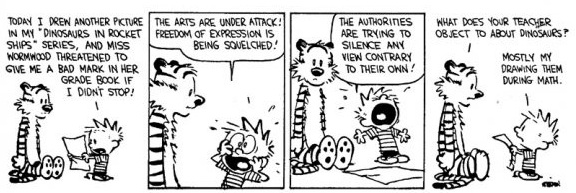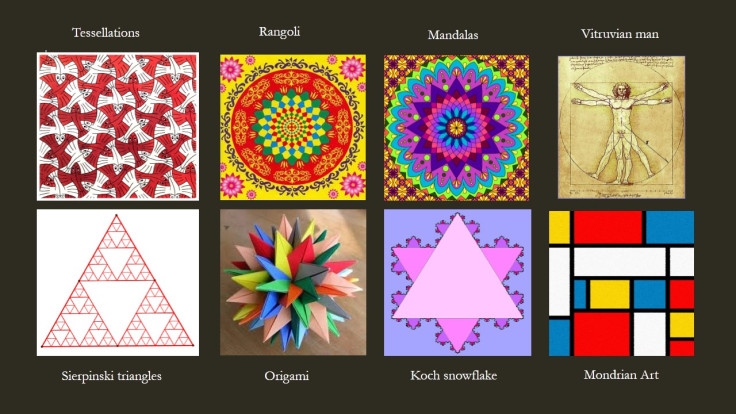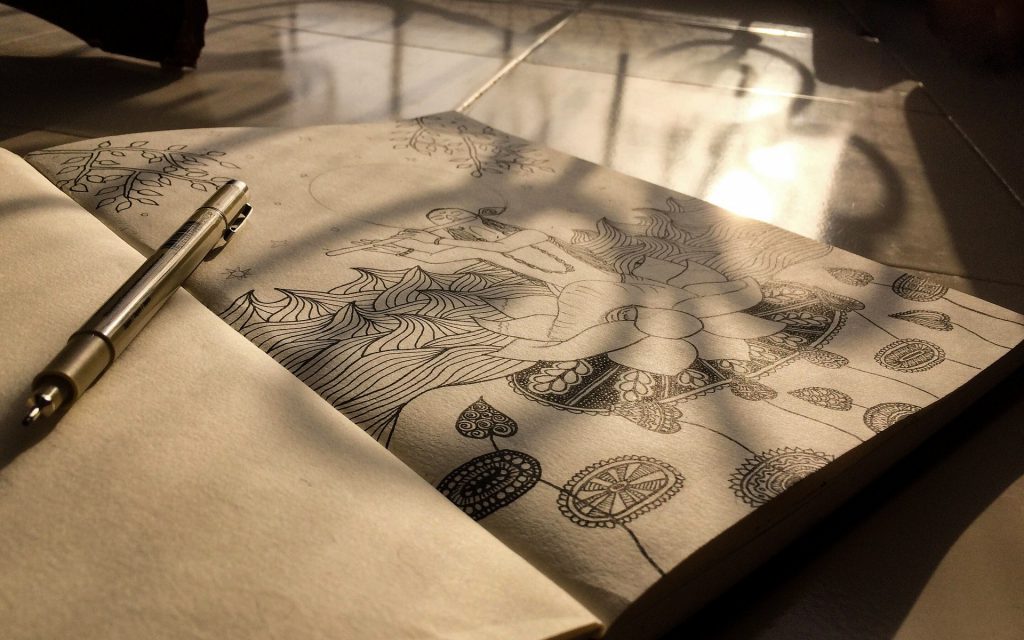In the child’s world…
Those of you who follow Calvin and Hobbes comic strips will agree that our six-year-old Calvin is quite the brat and an extraordinary drama queen (or king) when it comes to expressing opinions about education, art, universe, love and about life itself.
For those who are clueless about Calvin… here’s a simple introduction. Calvin is a six-year-old boy, who happens to be very mischievous and adventurous. His best buddy is Hobbes – his philosophical stuffed tiger who is really, really cute, I must add.
Calvin has difficulty understanding Maths and most often is lost in his imaginary world during the class. Miss Wormwood, happens to be his Maths teacher. She is a stereotypical teacher who means business and business only. She expects him to focus in class and learn to score well in tests, with no fun what so ever during class. Calvin gets caught drawing pictures of dinosaurs during Maths class every now and then.

What do we infer from this reference?
So now tell me how many of you can relate to Calvin here?
I am sure many of us can remember doodling or sketching during class because the topic was not made interesting enough to pay attention to, even though it was a very important topic to be learned.
At least I can recollect sketching portraits of my classmates during class and making paper boats out of the last pages of my rough notebook.
Mathematics and the symmetry in the universe
Well come to think of it I wish we would take these humorous strips a little more seriously and do something about our teaching approach in class. I feel that our teachers need to re-look at the way a topic is introduced and taught in class. There is a hidden artist in each one of us and kids for sure would appreciate Maths more, if one of the approaches used is art.
For instance, Geometry can be taught through Origami. Patterns, and Symmetry through Tessellations, Rangoli and Mandalas. Ratios and Proportions can be taught through the study of human body proportions – Vitruvian Man. Fractions, area, and perimeter can be taught through Mondrian art. Fractal geometry through Sierpinski triangles, Koch snowflake. Mull over these enchanting masterpieces for a few seconds and then tell me if this was a good idea or what?

So you see my point! Many topics in Maths can be taught through art. The subject has great potential for it and not to mention the immense joy one gets creating spectacular things as well as understand the Maths behind it. Maths can be anything but dry and boring.
We wrote about symmetry in the world around us in this incredible post a while back – https://blog.numbernagar.com/2019/06/21/discovering-mathematics-all-around-you/.
There are many mathematicians such as George Hart, Paul Nylander, Yongquan Lu and many more who are creative and are now using computer programming to generate beautiful mathematical master pieces.
In this context, I must tell you about this video tutorial I came across “Make your own Golden Ratio Seed Pattern Using Excel”.
It was amazing and cool to see the beautiful seed pattern emerge on the scatter plot from the numbers I had generated in the excel sheet. It was easy and you all must try it.
Also, you must watch this incredible video which I chanced upon while reading a blog on micro origami from newscientist.com.
This video is about artist Etienne Cliquet’s work named “Flotilla” a micro-origami (size of the artwork is just about 2 to 3 cms long) which opens slowly onto the surface of water due to capillary action. Here we see Art, Maths, and Science merge so seamlessly.
Closing words
The world around you is filled with mathematical shapes. You can discover these in your daily life or you can draw them while not paying particular attention to them. You just need to start looking for them and you’ll be surprised how many of them are out there.
All I have to say is “learning through art” is something I would strongly recommend to our beloved teacher community.
Image courtesy:
Feature Image: Image by Jinali Parikh from Pixabay
https://ibvisualarts.wordpress.com/2010/10/05/i-encourage-the-drawing-of-dinosaurs-in-math-class/
http://britton.disted.camosun.bc.ca/jbtess99.htm
http://desiznworld.com/2013/08/rangoli-designs-for-festivals.html
http://www.donteatthepaste.com/2011/11/mandala-to-color.html
http://blog.world-mysteries.com/science/vitruvian-man-by-leonardo-da-vinci/
http://jwilson.coe.uga.edu/emat6680/parsons/mvp6690/essay1/sierpinski.html
http://unitfun.tea-nifty.com/photos/suugaku/sz_stars02_051231.html
http://www.donbeaty.com/cjhs/fractal.html
https://www.tes.com/lessons/g3UFosoLdik0Ow/mondrian-art
Aruna Shankar
Latest posts by Aruna Shankar (see all)
- A Stitch In Time Saves Nine - 12 June 2020
- Doodle your way into Maths - 16 August 2019
- The Curious Case of the Mathematics behind the Illusions - 3 August 2019

